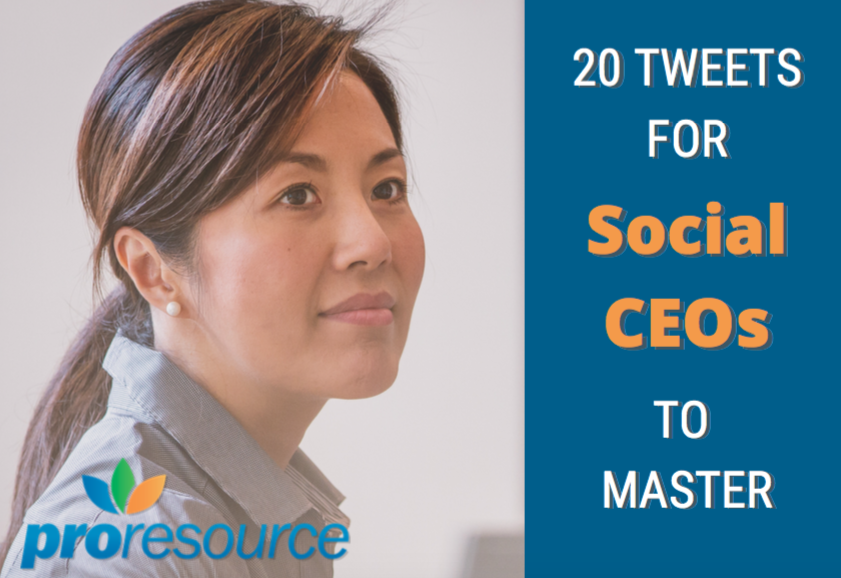It’s a question I hear all the time: “Is Twitter really something a CEO should be spending time on?”
For many CEOs, the answer is yes. Just look at the numbers — 500 million tweets are sent each day and with 326 million monthly users, 46% of them are accessing the platform daily. That’s a lot of reach!
Of course, the answer for your business might be no.
How to tell? Look to see if your stakeholders are on Twitter.
- Are there already discussions on Twitter about your brand?
- Are you trying to reach the media (a group that uses Twitter heavily)?
- Are you targeting younger consumers or employees? 80% of Twitter users are affluent Millennials.
- Are you targeting the government? Twitter is the #1 platform for government leaders.
If the answer to any of those questions is yes and you’re ignoring Twitter, you’re missing out on a huge opportunity.
As the public face of your company, people look to you to deliver valuable and honest information. This is not necessarily new – but what used to be delivered via press releases and media statements is now the domain of social media.
Twitter is seen as the social media platform where news is reported and discussed. It is also the platform where you can reach a large audience fast. CEOs can:
- Establish relationships with customers, media, influencers and employees
- Comment on industry news
- Personalize the company
- Crowdsource opinions
- Distribute original content (both personal and company-created)
Of all the social media platforms, Twitter is also the easiest to use.
Twitter Myths: Facts v. Fiction
Many high-ranking executives have been slow to get into social media, and CEOs are no exception. There has been a perception among many CEOs that Twitter is loud and noisy and discussions there are chaotic. That’s not wrong. But that shouldn’t keep you from participating. There’s considerable research showing the value.
CEO Reputation. 78% of executives working for CEOs who actively participate in social media say that their social participation has a positive impact on their company. These executives said their CEO’s participation in social media makes them feel inspired, technologically advanced, and proud. They rate a CEO who is active in social media as more forward-thinking, a better communicator, more effective, open and accessible, and inspiring. (See Weber Shandwick’s study The Social CEO.)
Twitter provides an excellent platform for employees to see the CEO’s human side. You can reach outside the normal hierarchy and engage up and down the organization. This promotes a healthy company culture, where the CEO is accessible and visible to all.
Of course, you can reach many other types of people on Twitter.
Time Commitment. Yes, Twitter can take up a lot of time. A company could have a team of full-time people on Twitter, some in marketing, others in customer service, and still not leverage it fully. But no one expects constant tweeting from a CEO.
Participate when you can. There will always be something interesting to read and engage with, and a little goes a long way.
Potential Risks. Are there risks for a CEO using social media? Absolutely. But there are greater risks in not participating. As a cautionary tale, read The 4 Billion Dollar Tweet.
When you have social media as one of the tools in your arsenal, you are better prepared to handle whatever arises. You can always get help from your communications team if you want it, but you also have full control over your own presence.
Top 20 Tweets for CEOs
So how can a CEO, who has virtually no free time, learn to use Twitter?
The easiest way is to watch people similar to you who are already using Twitter effectively and model their example.
In our new ebook, 20 Tweets for Social CEOs to Master, we have done the research for you. We followed Fortune 500 CEOs who are active on Twitter and identified twenty different types of tweets they make on a regular basis:
- Tell Client Stories
- Appear on the News
- Acknowledge an Award
- Enjoy a Conference
- Share Something Personal
- Express Frustration
- Retweet Company News
- Apologize for a Mistake
- Respond to a Crisis
- Provide Industry Insights
- Announce a Podcast or Speaking Engagement
- Promote a Cause
- Share Holiday Greetings
- Appreciate Employees Who Go the Extra Mile
- Applaud Employee Achievements
- Congratulate Clients or Partners
- Comment on Current Events
- Celebrate a Win
- Post a Selfie with a Celebrity
- Ask for Advice
The ebook includes examples of each type of tweet. You’ll see how these CEOs craft their tweets, how they acknowledge awards and good news without bragging, how they interact with people, and how they share issues that matter to them personally.
Then you can use these ideas in your own tweets, and demonstrate that you, too, are a social CEO. Download your free copy of the 20 Tweets ebook today!
If you want to keep up with these CEOs on an ongoing basis, use our F500 CEOs Twitter list, which you can check anytime for the latest tweets from Fortune 500 CEOs.

